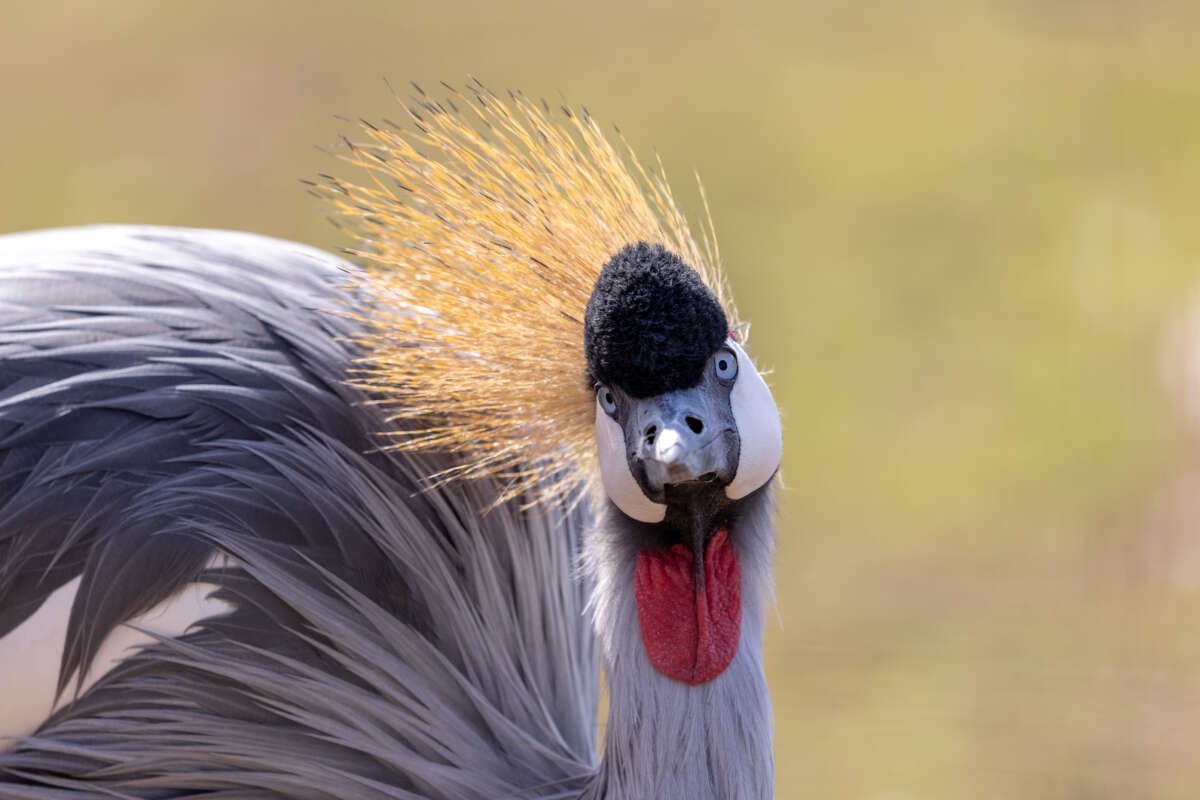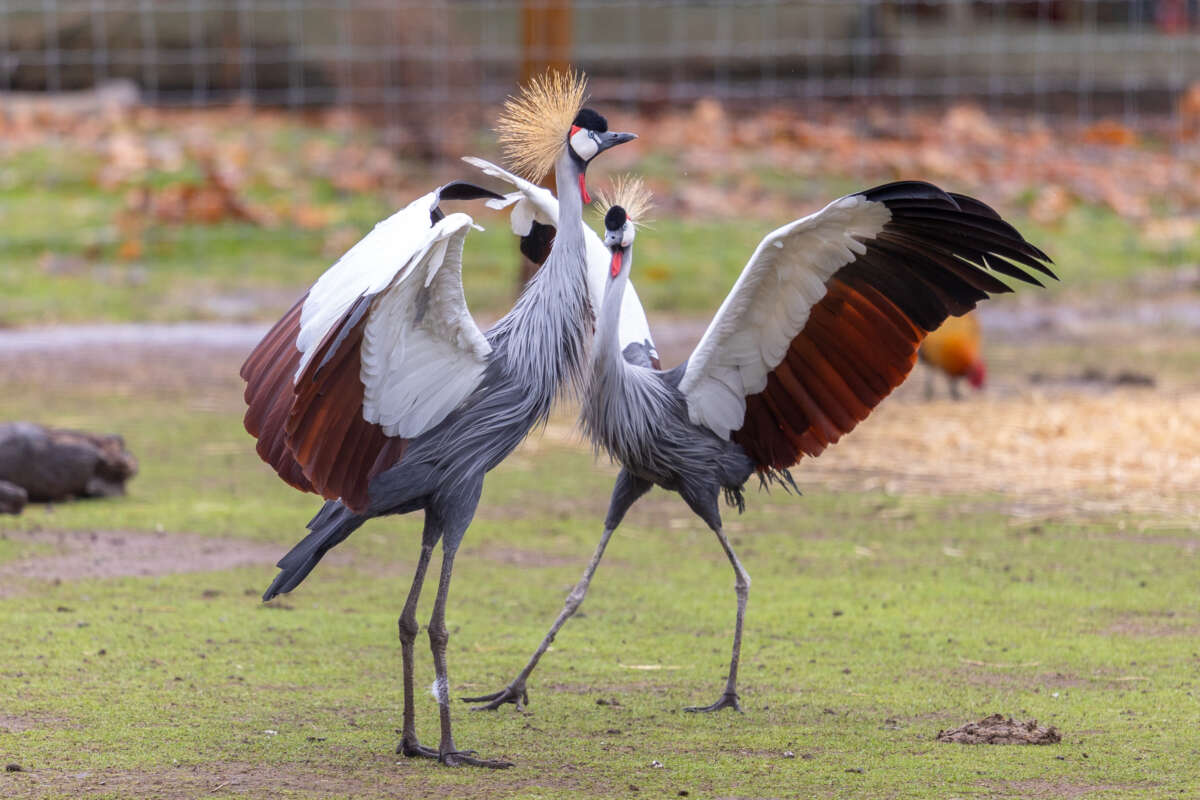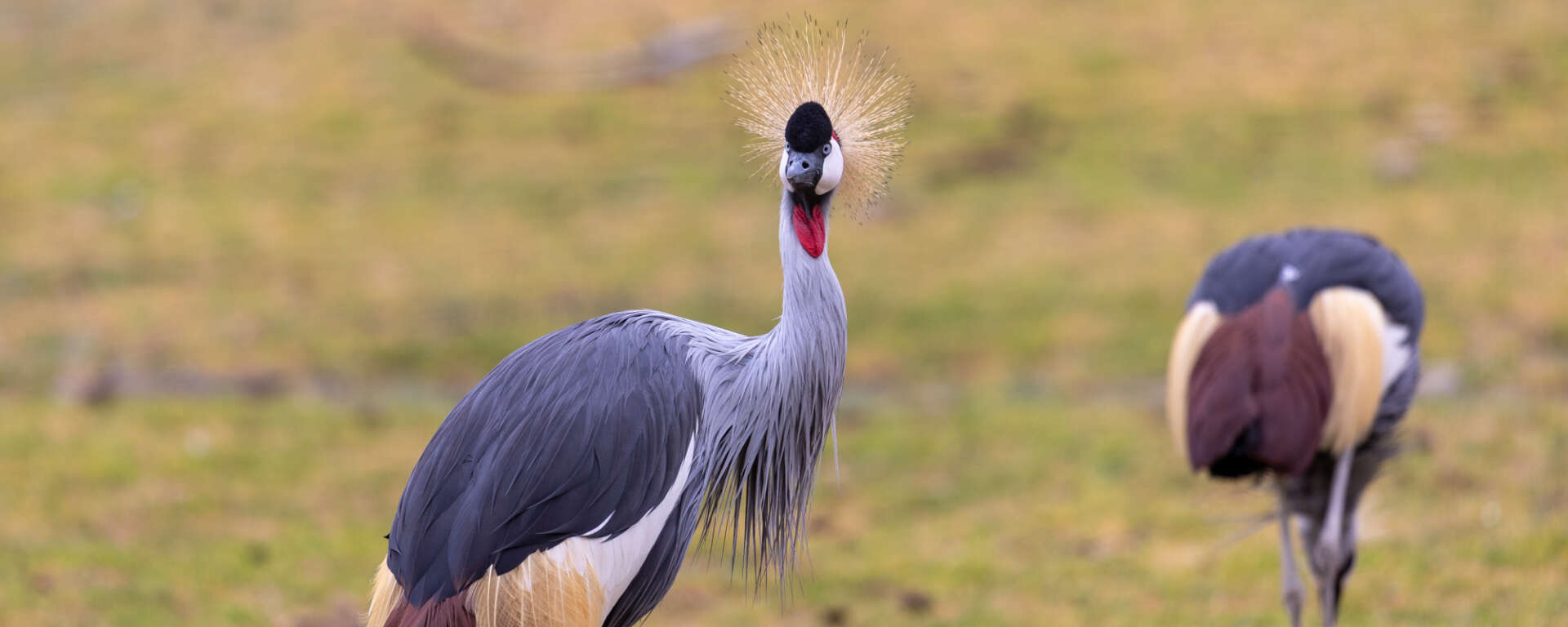Description
The gray crowned crane is a tall, majestic bird with a distinctive crown of golden feathers on its head. It has large white cheek patches with a bright red wattle beneath. The east African subspecies of gray crowned crane has an additional section of red at the top of its cheek patches. This crane has a slate-gray body, a white leading edge on the top and bottom of its wings, and flight feathers that move from brown to black as they get farther from the body.
Cover photo: Adult gray crowned crane by Mark Pressler
Classification
- Overview
- Gray crowned cranes are birds in the gruid, or crane family. The only other bird that shares the genus Balearica with the gray crowned crane is the black crowned crane, which looks very similar but has darker body feathers and lives in western and central Africa above the equator.
- Class
- Aves
- Order
- Gruiformes
- Family
- Gruidae
- Genus
- Balearica
- Species
- B. regulorum
Key Facts
- Conservation Status
- Endangered
- Lifespan
- ~22 years in the wild; up to 43 years under human care
- Height
- ~3.3 – 3.6 ft (~100 – 110 cm)
- Weight
- ~6.6 – 8.8 lb (~3 – 4 kg)
- Wingspan
- ~5.9 – 6.6 ft (~180 – 200 cm)
The IUCN Red List describes the gray crowned crane as Endangered. The most recent assessment in 2016 found a decreasing population of about 17,500 – 22,500 mature birds in the wild. Loss and degradation of habitat, such as the draining of swamps and marshland for agriculture, account for much of the species decline. An additional factor affecting decline is the illegal poaching of these birds for a variety of uses, including international trade.
Conservation organizations across many countries in eastern and southern Africa are starting to develop and implement plans to conserve habitat and reduce poaching of the gray crowned crane. In Rwanda, the Rwanda Wildlife Conservation Association is working hard to patrol gray crowned crane habitat and prevent poaching events, as well as engage locals in community workshops and community science monitoring projects. Their efforts have resulted in a doubling of gray crowned crane numbers in Rwanda between censuses in 2017 and 2021! Although Rwanda holds only a small percentage of gray crowned cranes, this work is worth highlighting—any and all effort is helpful in the continued survival of these birds.
Social life
Gray crowned cranes are social and gregarious during most of the year, moving about in flocks of up to 100 and roosting in trees or riverbeds.
Cranes are monogamous—mated pairs will stay together throughout the course of a year and share chick-rearing duties, and will sometimes remain together over many years until one bird dies. Studies on the most extensively studied crane, the sandhill crane, have found that if pairs are continuously unsuccessful in their reproductive efforts, there is a good chance the pair will split, while pairs that successfully raise chicks often stay together.
Like all crane species, gray crowned cranes exhibit extravagant dancing behavior. Crowned cranes have an especially distinctive dance which includes bobbing their heads, bowing, spreading their wings and leaping while circling one another. This dancing has a variety of functions: in young birds it is likely a form of their physical and behavioral development, in unpaired adult birds it is a form of socialization and pair formation, and in paired birds it may serve to strengthen the pair bond. Within flocks, the excitement of a dance often spreads and results in many birds dancing together. Crowned crane courtship displays also incorporate a sequence of low, booming unison calls.
Habitat & Range
Gray crowned cranes are found in eastern Zaire, Uganda, Rwanda, Kenya, and Tanzania. They are found in marshes and grasslands near rivers and lakes as well as near cultivated land. Gray crowned cranes are considered non-migratory. They will move varying distances locally depending on the duration and intensity of the rainy season, but do not undertake any cross-continental migrations.
Diet
Cranes are largely opportunistic, generalist feeders that will eat a wide range of plant and animal foods. Gray crowned cranes are omnivorous, feeding on grains, berries, small fruits, tender roots, insect larvae, worms, snails, amphibians, reptiles, small birds and mammals, and a few fish. Crowned cranes will stamp the ground to stir up insects, which they quickly grab with their short beaks.
Reproduction
Sexual maturity: 3 years
Mating Season: Dependent on the rainy season
Incubation: 28 – 35 days
Number of young: 2 – 4 eggs per clutch
- Information
-
Description
The gray crowned crane is a tall, majestic bird with a distinctive crown of golden feathers on its head. It has large white cheek patches with a bright red wattle beneath. The east African subspecies of gray crowned crane has an additional section of red at the top of its cheek patches. This crane has a slate-gray body, a white leading edge on the top and bottom of its wings, and flight feathers that move from brown to black as they get farther from the body.
Cover photo: Adult gray crowned crane by Mark Pressler
Classification
- Overview
- Gray crowned cranes are birds in the gruid, or crane family. The only other bird that shares the genus Balearica with the gray crowned crane is the black crowned crane, which looks very similar but has darker body feathers and lives in western and central Africa above the equator.
- Class
- Aves
- Order
- Gruiformes
- Family
- Gruidae
- Genus
- Balearica
- Species
- B. regulorum
Key Facts
- Conservation Status
- Endangered
- Lifespan
- ~22 years in the wild; up to 43 years under human care
- Height
- ~3.3 – 3.6 ft (~100 – 110 cm)
- Weight
- ~6.6 – 8.8 lb (~3 – 4 kg)
- Wingspan
- ~5.9 – 6.6 ft (~180 – 200 cm)
- Conservation
The IUCN Red List describes the gray crowned crane as Endangered. The most recent assessment in 2016 found a decreasing population of about 17,500 – 22,500 mature birds in the wild. Loss and degradation of habitat, such as the draining of swamps and marshland for agriculture, account for much of the species decline. An additional factor affecting decline is the illegal poaching of these birds for a variety of uses, including international trade.
Conservation organizations across many countries in eastern and southern Africa are starting to develop and implement plans to conserve habitat and reduce poaching of the gray crowned crane. In Rwanda, the Rwanda Wildlife Conservation Association is working hard to patrol gray crowned crane habitat and prevent poaching events, as well as engage locals in community workshops and community science monitoring projects. Their efforts have resulted in a doubling of gray crowned crane numbers in Rwanda between censuses in 2017 and 2021! Although Rwanda holds only a small percentage of gray crowned cranes, this work is worth highlighting—any and all effort is helpful in the continued survival of these birds.
- Lifestyle
Social life
Gray crowned cranes are social and gregarious during most of the year, moving about in flocks of up to 100 and roosting in trees or riverbeds.Cranes are monogamous—mated pairs will stay together throughout the course of a year and share chick-rearing duties, and will sometimes remain together over many years until one bird dies. Studies on the most extensively studied crane, the sandhill crane, have found that if pairs are continuously unsuccessful in their reproductive efforts, there is a good chance the pair will split, while pairs that successfully raise chicks often stay together.
Like all crane species, gray crowned cranes exhibit extravagant dancing behavior. Crowned cranes have an especially distinctive dance which includes bobbing their heads, bowing, spreading their wings and leaping while circling one another. This dancing has a variety of functions: in young birds it is likely a form of their physical and behavioral development, in unpaired adult birds it is a form of socialization and pair formation, and in paired birds it may serve to strengthen the pair bond. Within flocks, the excitement of a dance often spreads and results in many birds dancing together. Crowned crane courtship displays also incorporate a sequence of low, booming unison calls.
Habitat & Range
Gray crowned cranes are found in eastern Zaire, Uganda, Rwanda, Kenya, and Tanzania. They are found in marshes and grasslands near rivers and lakes as well as near cultivated land. Gray crowned cranes are considered non-migratory. They will move varying distances locally depending on the duration and intensity of the rainy season, but do not undertake any cross-continental migrations.Diet
Cranes are largely opportunistic, generalist feeders that will eat a wide range of plant and animal foods. Gray crowned cranes are omnivorous, feeding on grains, berries, small fruits, tender roots, insect larvae, worms, snails, amphibians, reptiles, small birds and mammals, and a few fish. Crowned cranes will stamp the ground to stir up insects, which they quickly grab with their short beaks.Reproduction
Sexual maturity: 3 years
Mating Season: Dependent on the rainy season
Incubation: 28 – 35 days
Number of young: 2 – 4 eggs per clutch

Gray crowned crane portrait by Mark Pressler

Gray crowned cranes dancing by Mark Pressler

